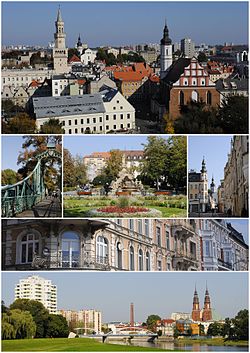Opole
| Opole | |||
|---|---|---|---|

Old Town
|
|||
|
|||
| Coordinates: 50°40′N 17°56′E / 50.667°N 17.933°E | |||
| Country | Poland | ||
| Voivodeship | Opole | ||
| County | city county | ||
| Town rights | 1217 | ||
| Government | |||
| • Mayor | Arkadiusz Wiśniewski | ||
| Area | |||
| • City | 148.99 km2 (57.53 sq mi) | ||
| Elevation | 176 m (577 ft) | ||
| Population (2017) | |||
| • City | 127,792 | ||
| • Density | 860/km2 (2,200/sq mi) | ||
| • Metro | 267,000 | ||
| Time zone | CET (UTC+1) | ||
| • Summer (DST) | CEST (UTC+2) | ||
| Postal code | 45-001 to 45-960 | ||
| Area code(s) | +48 077 | ||
| Car plates | OP | ||
| Website | http://www.opole.pl | ||
Opole [ɔˈpɔlɛ] (German: Oppeln, Silesian German: Uppeln, Silesian: Uopole) is a city located in southern Poland on the Oder River (Odra). With a population of approximately 127,792 (January 2017), it is the capital of the Opole Voivodeship and, also the seat of Opole County.
With it long history dating back to the 9th century, Opole is considered to be one of the oldest towns in Poland. The origins of the first settlement are connected with the town being granted Magdeburg Rights in 1217 by Casimir I of Opole, the great-grandson of Polish Duke Bolesław III Wrymouth. During the Medieval Period and the Renaissance the city was known as a centre of commerce due to its position on the intersection of several main trade routes, which helped to generate steady profits from transit trade. The rapid development of the town was also caused by the establishment of a seat of regency in Opole in 1816. The first railway connection between Opole, Brzeg and Wrocław was opened in 1843 and the first proper manufacturing plants were constructed in 1859, which greatly contributed to the city's regional significance.
During its existence Opole belonged to Poland, Bohemia, Prussia and Germany. Prior to World War II it was located in eastern Germany and was one of the largest centres of Polish minority in the entire country. In 1945, according to Yalta and Potsdam Agreements, the region was assigned to Poland. Many German Upper Silesians and Poles of German ancestry still live in the Opole region; in the city itself, however, ethnic Germans make up less than 3% of the population. It was also the capital of the historical region of Upper Silesia.
...
Wikipedia



